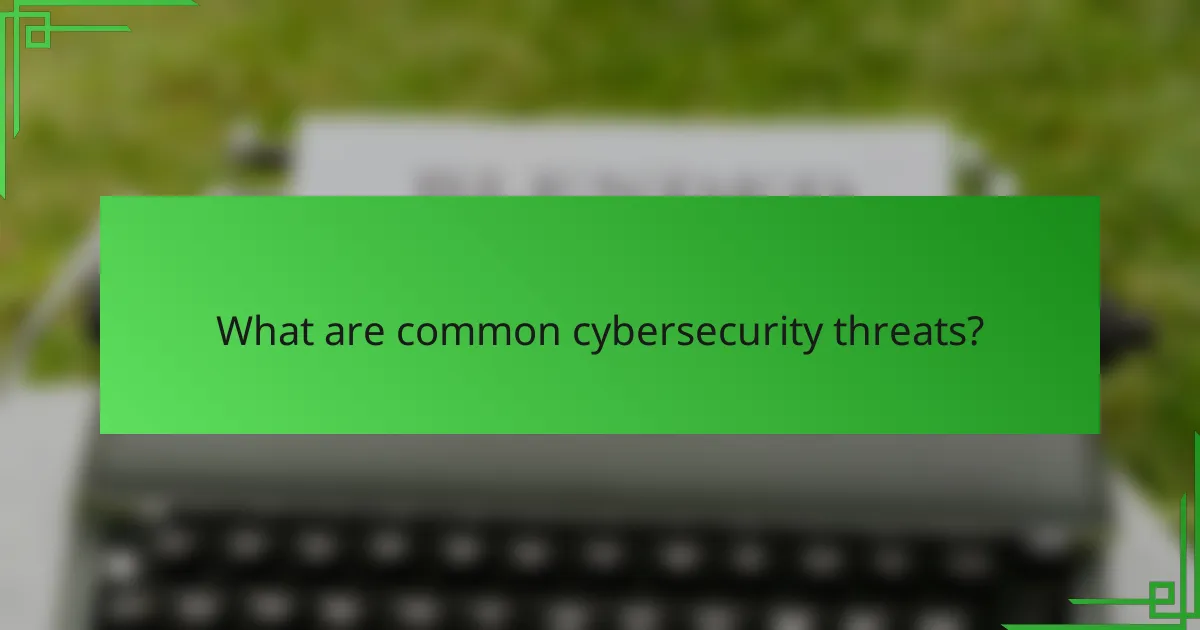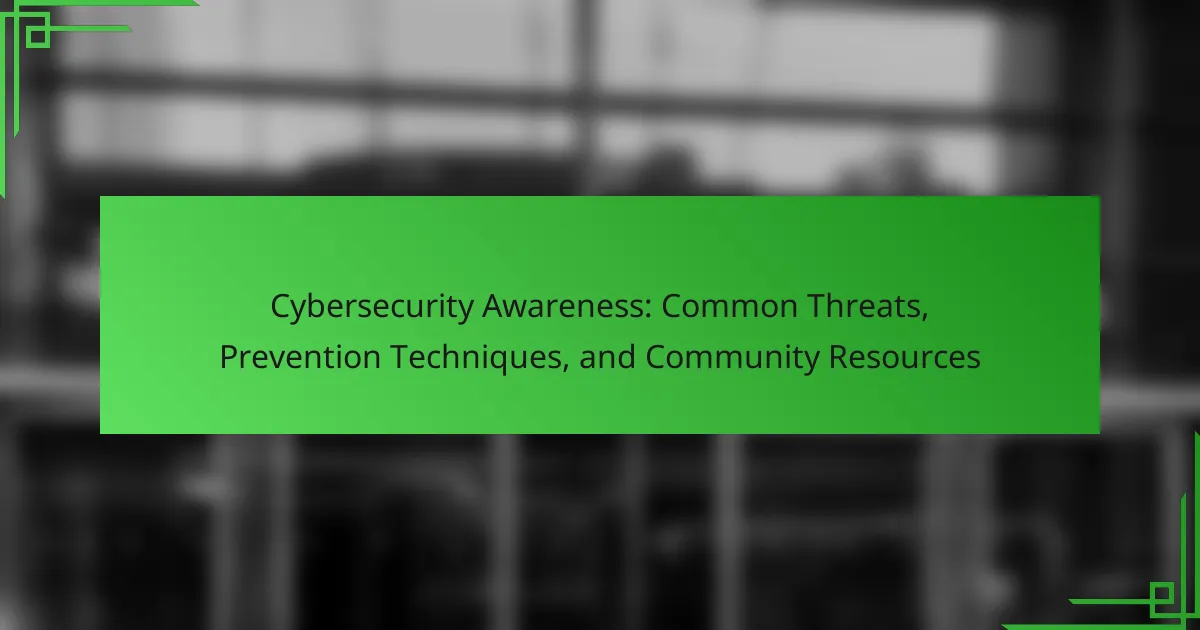Cybersecurity awareness encompasses the understanding of potential cyber threats and the implementation of safe online practices. Key threats include malware, phishing, ransomware, and denial-of-service attacks, which can significantly impact individuals and organizations. Effective cybersecurity awareness training can reduce the risk of successful cyber attacks by up to 70%, emphasizing the necessity of ongoing education about these threats. Regular training programs should cover essential topics such as password security and phishing recognition, while community resources like workshops and online courses can further enhance public knowledge. By fostering a culture of security and utilizing available resources, individuals can better protect themselves against cyber threats.

What is Cybersecurity Awareness?
Cybersecurity awareness is the understanding and knowledge of potential cyber threats and safe online practices. It involves recognizing risks such as phishing, malware, and data breaches. Individuals trained in cybersecurity awareness can identify suspicious activities and take appropriate actions. For instance, a study by the Ponemon Institute found that organizations with cybersecurity awareness programs reduce the likelihood of successful cyber attacks by 70%. This highlights the importance of educating users about cybersecurity measures.
Why is Cybersecurity Awareness important for individuals and organizations?
Cybersecurity awareness is crucial for individuals and organizations to protect sensitive information. It helps in identifying potential threats such as phishing attacks and malware. Awareness reduces the risk of data breaches, which can lead to financial losses. According to the Cybersecurity & Infrastructure Security Agency, 90% of cyber incidents involve human error. Training employees on security best practices enhances overall security posture. Individuals who understand cybersecurity can better safeguard personal data. Organizations benefit from reduced liability and compliance with regulations. Ultimately, awareness fosters a culture of security, making it a shared responsibility.
What are the potential consequences of lacking Cybersecurity Awareness?
Lacking cybersecurity awareness can lead to severe consequences, including data breaches and financial losses. Individuals and organizations may fall victim to phishing attacks due to insufficient knowledge. Without awareness, users are more likely to use weak passwords, making accounts vulnerable. This can result in unauthorized access to sensitive information. Additionally, malware infections can occur when users click on malicious links. These infections can compromise entire networks, leading to operational disruptions. The global cost of cybercrime is projected to reach $10.5 trillion annually by 2025, highlighting the financial impact of such negligence. Furthermore, reputational damage can occur when a breach is publicized, affecting customer trust and loyalty.
How does Cybersecurity Awareness contribute to overall safety?
Cybersecurity awareness enhances overall safety by educating individuals about potential online threats. This knowledge enables users to recognize phishing attempts, malware, and social engineering tactics. Awareness training can reduce the likelihood of successful cyberattacks. According to a study by the Ponemon Institute, organizations with regular cybersecurity training experience 50% fewer security incidents. Informed users are more likely to adopt safe online practices. They are also better equipped to respond to security breaches effectively. Thus, cybersecurity awareness plays a crucial role in creating a safer digital environment.
What are the key components of Cybersecurity Awareness?
The key components of Cybersecurity Awareness include understanding threats, recognizing safe practices, and promoting security culture. Understanding threats involves identifying common cyber risks such as phishing, malware, and social engineering. Recognizing safe practices means knowing how to create strong passwords, update software regularly, and avoid suspicious links. Promoting security culture encourages individuals to share knowledge and report incidents. These components collectively enhance an organization’s security posture. According to the Cybersecurity & Infrastructure Security Agency (CISA), training employees on these aspects can significantly reduce the risk of breaches.
How do training programs enhance Cybersecurity Awareness?
Training programs enhance Cybersecurity Awareness by providing targeted education on potential threats. These programs teach employees to recognize phishing attempts, malware, and social engineering tactics. Awareness training increases vigilance against cyber threats. Studies show that organizations with regular training see a 70% reduction in security incidents. Participants learn best practices for password management and data protection. Engaging training formats, such as simulations and interactive sessions, improve retention of information. Regular updates in training content ensure relevance to evolving threats. Overall, training programs foster a culture of security within organizations.
What role does communication play in fostering Cybersecurity Awareness?
Communication is essential in fostering cybersecurity awareness. It facilitates the sharing of critical information regarding threats and preventive measures. Effective communication helps individuals understand the complexities of cybersecurity risks. Regular updates and training sessions enhance knowledge and preparedness. Studies show that organizations with strong communication strategies report fewer security incidents. For instance, a 2020 report by the Ponemon Institute highlights that effective communication reduces the likelihood of breaches by 30%. Clear messaging also encourages a culture of security within organizations. This culture empowers employees to recognize and respond to potential threats. Therefore, communication is a vital component in building a proactive cybersecurity environment.

What are common cybersecurity threats?
Common cybersecurity threats include malware, phishing, ransomware, and denial-of-service attacks. Malware refers to malicious software designed to harm systems or steal data. Phishing involves deceptive emails aimed at tricking individuals into revealing sensitive information. Ransomware encrypts files and demands payment for decryption. Denial-of-service attacks overwhelm systems to render them unusable. According to the Cybersecurity & Infrastructure Security Agency (CISA), these threats are prevalent and can cause significant damage to organizations and individuals alike.
What types of cyber threats should individuals be aware of?
Individuals should be aware of several types of cyber threats. These include malware, which is software designed to harm or exploit any programmable device. Phishing attacks are also prevalent; they trick individuals into revealing personal information through deceptive emails or websites. Ransomware is another serious threat, encrypting files and demanding payment for access. Social engineering exploits human psychology to manipulate individuals into divulging confidential information. Additionally, denial-of-service (DoS) attacks overwhelm systems, making them unavailable to users. Data breaches occur when unauthorized entities access sensitive information, often leading to identity theft. Lastly, insider threats involve current or former employees who misuse their access to harm the organization. According to the Cybersecurity & Infrastructure Security Agency, these threats are increasingly common and can have significant impacts on individuals and organizations alike.
How do phishing attacks work and how can they be recognized?
Phishing attacks work by tricking individuals into providing sensitive information. Attackers often use emails or messages that appear to be from legitimate sources. These communications typically contain links to fake websites designed to resemble real ones. When users enter their information, it is captured by the attackers.
Recognizing phishing attacks involves looking for certain signs. Common indicators include poor spelling and grammar in messages. Unusual sender addresses or requests for personal information are also red flags. Legitimate organizations typically do not ask for sensitive data via email. Hovering over links to check their actual destination can reveal inconsistencies.
According to the Anti-Phishing Working Group, there were over 200,000 reported phishing attacks in a single month in 2020. This statistic highlights the prevalence of such threats and the need for vigilance.
What are the characteristics of malware and its various forms?
Malware is malicious software designed to disrupt, damage, or gain unauthorized access to computer systems. Key characteristics include self-replication, stealth, and harm to data integrity. Malware often disguises itself to avoid detection. It can take various forms such as viruses, worms, Trojans, ransomware, spyware, and adware. Viruses attach to files and spread when executed. Worms replicate independently across networks. Trojans masquerade as legitimate software to deceive users. Ransomware encrypts files and demands payment for decryption. Spyware secretly gathers user information. Adware displays unwanted advertisements. Each form of malware has unique methods of attack and impact on systems.
How do social engineering tactics exploit human behavior?
Social engineering tactics exploit human behavior by manipulating psychological triggers. These tactics often rely on trust, fear, and urgency. For instance, attackers may pose as authority figures to gain compliance. They might use phishing emails that create a sense of urgency to prompt quick responses. Research shows that 93% of successful data breaches begin with a phishing attack. This indicates the effectiveness of exploiting human emotions. Additionally, social engineers often personalize their attacks to increase credibility. By using information from social media, they can craft convincing messages. This tailored approach enhances the likelihood of manipulation.
What are some examples of social engineering attacks?
Phishing, pretexting, baiting, and tailgating are examples of social engineering attacks. Phishing involves tricking individuals into providing sensitive information via fake emails or websites. Pretexting requires an attacker to create a fabricated scenario to obtain confidential data. Baiting lures victims with promises of rewards, such as free software or gifts, to gain access to their systems. Tailgating occurs when an unauthorized person follows an authorized individual into a secure area. These attacks exploit human psychology to bypass security measures. According to the 2021 Verizon Data Breach Investigations Report, social engineering accounted for 36% of data breaches.
How can individuals protect themselves from social engineering threats?
Individuals can protect themselves from social engineering threats by being aware of common tactics used by attackers. They should verify the identity of anyone requesting sensitive information. This can involve calling back a known number rather than using contact details provided by the requester. Individuals should also avoid sharing personal information on social media. Many attackers gather information from these platforms to craft convincing messages.
Using strong, unique passwords for different accounts is essential. Password management tools can help in maintaining security. Regularly updating software and systems can protect against vulnerabilities that attackers exploit.
Training and awareness programs can significantly reduce the risk of falling victim to social engineering. Research shows that organizations with regular training see a decrease in successful attacks. According to a study by the Ponemon Institute, organizations that conducted security awareness training reduced phishing susceptibility by up to 70%.
Finally, individuals should report any suspicious activity to relevant authorities. This can help prevent further attacks on themselves and others.

What prevention techniques can enhance cybersecurity awareness?
Regular training and education can enhance cybersecurity awareness. Employees should participate in ongoing cybersecurity training programs. These programs should cover topics like phishing, password security, and safe internet practices. Simulated phishing attacks can help reinforce learning. Additionally, creating a culture of security encourages employees to report suspicious activities. Regular updates about new threats can keep awareness high. Implementing clear policies and procedures also supports cybersecurity practices. Lastly, utilizing visual reminders like posters can reinforce key messages in the workplace.
What best practices should individuals follow to stay safe online?
Individuals should use strong, unique passwords for each online account. This reduces the risk of unauthorized access. Passwords should be at least 12 characters long and include a mix of letters, numbers, and symbols.
Two-factor authentication adds an extra layer of security. This requires a second form of verification, such as a text message code. Regularly updating software and applications helps protect against vulnerabilities.
Individuals should be cautious with emails and links from unknown sources. Phishing attacks are common and can compromise personal information. Using secure connections, such as VPNs, enhances privacy when accessing public Wi-Fi.
Monitoring bank and credit card statements can help identify unauthorized transactions. Cybersecurity awareness training can provide valuable information on recognizing threats. Following these best practices significantly reduces the risk of cyber threats.
How can strong passwords contribute to cybersecurity?
Strong passwords significantly enhance cybersecurity by making unauthorized access difficult. They are typically longer and include a mix of uppercase letters, lowercase letters, numbers, and special characters. This complexity increases the time and effort required for attackers to guess or crack the password.
According to a study by the National Institute of Standards and Technology (NIST), using passwords that are at least 12 characters long can drastically reduce the risk of compromise. Additionally, strong passwords help protect sensitive data and personal information from breaches.
In 2020, the Verizon Data Breach Investigations Report indicated that 80% of hacking-related breaches involved weak or stolen passwords. Thus, implementing strong passwords is a crucial step in safeguarding against cyber threats.
What role does regular software updates play in prevention?
Regular software updates play a crucial role in cybersecurity prevention. They address vulnerabilities in software that can be exploited by attackers. Each update often includes patches that fix security flaws. For instance, a 2020 report by the Cybersecurity and Infrastructure Security Agency (CISA) emphasized that unpatched software is a primary target for cybercriminals. Regular updates also enhance software performance and functionality. By keeping software current, users reduce the risk of malware infections. The National Institute of Standards and Technology (NIST) recommends timely updates as a best practice for maintaining security. Overall, consistent software updates are essential for protecting systems against evolving threats.
How can organizations implement effective cybersecurity training?
Organizations can implement effective cybersecurity training by developing a structured program. This program should include regular training sessions to educate employees about current threats. It is essential to use real-world examples and scenarios to illustrate risks. Interactive modules can enhance engagement and retention of information. Organizations should assess employees’ understanding through quizzes and practical exercises. Regular updates to training content are necessary to reflect evolving threats. Feedback from participants can help improve future training sessions. According to a 2021 report by the Ponemon Institute, organizations with regular training programs see a 50% reduction in security breaches.
What are the essential elements of a cybersecurity training program?
The essential elements of a cybersecurity training program include risk awareness, policy education, and practical exercises. Risk awareness helps employees understand potential threats. Policy education ensures that staff are familiar with organizational security protocols. Practical exercises give hands-on experience in identifying and responding to incidents. Regular updates to training materials keep content relevant. Assessment of employee knowledge through testing measures effectiveness. A feedback mechanism allows for continuous improvement of the program. These elements collectively enhance overall cybersecurity posture.
How can organizations measure the effectiveness of their training?
Organizations can measure the effectiveness of their training through various methods. One common approach is to use pre- and post-training assessments. These assessments evaluate knowledge gained by comparing scores before and after training sessions. Another method is to track employee performance metrics related to cybersecurity incidents. A reduction in incidents after training indicates improved awareness. Surveys and feedback forms can also gauge participant satisfaction and perceived value of the training. Additionally, organizations may conduct simulated phishing attacks to assess real-world application of training. The results can highlight areas needing further improvement. Regular audits of security practices post-training can provide insights into long-term effectiveness. These methods collectively ensure a comprehensive evaluation of training effectiveness in enhancing cybersecurity awareness.

What community resources are available for cybersecurity awareness?
Community resources for cybersecurity awareness include local workshops, online courses, and public seminars. Organizations such as the Cybersecurity and Infrastructure Security Agency (CISA) offer free resources and training materials. Nonprofits like the National Cyber Security Alliance provide educational programs aimed at various demographics. Schools and libraries often host events to educate the public about online safety. Additionally, community centers may partner with cybersecurity experts for informational sessions. These resources help individuals understand threats and improve their cybersecurity practices.
What local organizations offer cybersecurity awareness programs?
Local organizations that offer cybersecurity awareness programs include community colleges, public libraries, and local non-profits. These organizations often provide workshops and training sessions. For example, the National Cyber Security Alliance partners with various local entities. They offer resources and support for community education. Additionally, local chambers of commerce may host cybersecurity seminars. Schools and universities also implement programs for students and staff. Many of these initiatives aim to educate the public on online safety practices.
How can community workshops improve public knowledge on cybersecurity?
Community workshops can significantly improve public knowledge on cybersecurity by providing hands-on learning experiences. These workshops offer practical demonstrations of cybersecurity threats and prevention techniques. Participants can engage in interactive sessions that clarify complex concepts. This approach enhances retention of information compared to traditional learning methods. Studies indicate that experiential learning increases understanding and application of skills. For example, a report by the National Cyber Security Centre found that community engagement improves awareness and proactive behavior towards cyber threats. Workshops also foster discussions that address specific community concerns. This tailored approach ensures that the information is relevant and applicable. Overall, community workshops serve as effective platforms for enhancing cybersecurity knowledge among the public.
What online resources and platforms provide valuable cybersecurity information?
Online resources and platforms that provide valuable cybersecurity information include websites like the Cybersecurity and Infrastructure Security Agency (CISA) and the National Institute of Standards and Technology (NIST). CISA offers guidelines, alerts, and best practices for protecting against cyber threats. NIST provides comprehensive frameworks and standards for managing cybersecurity risk. Additionally, platforms like Krebs on Security and the SANS Institute offer insights, research, and training on current cybersecurity issues. These sources are recognized for their credibility and are frequently referenced by professionals in the field.
How can individuals get involved in promoting cybersecurity awareness in their communities?
Individuals can promote cybersecurity awareness in their communities by organizing workshops. Workshops can educate attendees on common threats and prevention techniques. They can also distribute informational materials like brochures and flyers. Social media campaigns can raise awareness about cybersecurity issues. Collaborating with local schools and organizations can extend outreach. Hosting community events focused on cybersecurity can engage more participants. Sharing personal experiences with cyber threats can resonate with others. Joining or forming local cybersecurity groups can foster ongoing discussions.
What volunteer opportunities exist for cybersecurity advocacy?
Volunteer opportunities for cybersecurity advocacy include participating in local cybersecurity awareness programs. Organizations often seek volunteers to help educate communities about online safety. Volunteer roles may involve conducting workshops or seminars on cybersecurity best practices. Many nonprofits focus on teaching digital literacy and safe online behaviors. Additionally, volunteering with cybersecurity organizations can include supporting outreach initiatives. Some opportunities involve creating educational content or resources. Engaging in community events to promote cybersecurity awareness is also common. These activities help raise awareness about threats and prevention techniques.
How can social media be used to spread awareness about cybersecurity?
Social media can effectively spread awareness about cybersecurity by facilitating the rapid sharing of information. Platforms like Twitter and Facebook allow organizations to post updates on threats and best practices. Visual content, such as infographics and videos, can simplify complex topics. Engaging posts encourage user interaction and sharing. Hashtags can help organize discussions and reach wider audiences. Collaborations with influencers can amplify messages. Regular campaigns can keep cybersecurity in public discourse. According to a 2021 report by Cybersecurity & Infrastructure Security Agency, social media campaigns significantly increased public engagement on cybersecurity topics.
What are some practical tips for enhancing personal cybersecurity awareness?
To enhance personal cybersecurity awareness, individuals should adopt several practical tips. First, regularly update software and operating systems to protect against vulnerabilities. Second, use strong, unique passwords for each account. Passwords should include a mix of letters, numbers, and symbols. Third, enable two-factor authentication wherever possible for an added layer of security. Fourth, be cautious of phishing emails and do not click on suspicious links. Fifth, educate yourself about common cybersecurity threats and best practices. Sixth, regularly back up important data to mitigate loss from cyber incidents. Finally, utilize reputable security software to detect and prevent threats. These practices significantly reduce the risk of cyberattacks and enhance overall awareness.
Cybersecurity awareness is the understanding of potential cyber threats and safe online practices, crucial for protecting sensitive information for both individuals and organizations. This article covers common cybersecurity threats such as phishing, malware, and social engineering, alongside prevention techniques, including strong password usage and regular software updates. It highlights the importance of training programs in enhancing awareness and discusses community resources available for education and engagement. Additionally, the article outlines the consequences of lacking cybersecurity awareness and offers practical tips for individuals to improve their online safety.


